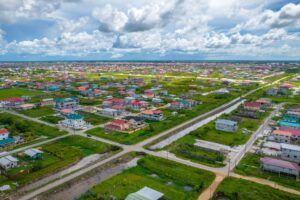What is development? Is it good or bad for us and future generations? If it is not good, how can we make it good? Continue reading to learn more about this concept, and you will be able to answer these questions for yourself.
Jolly and Santos (2016) posited that in the 1940s, the rich countries were referred to as developed, and the poor countries were referred to as the third world or underdeveloped or developing countries. From those classifications, the concept of development can be interpreted as a process of moving from an underdeveloped state to becoming developed. Global development, according to Currie-Alder (2016), is development practices that are focused on “creating a common future, recognising the interdependence of different countries in producing public goods and confronting public ills” (p. 8). How to approach development seems to be a significant challenge. Over the last few decades, development narratives have evolved (Jolly & Santos, 2016) to meet the demands of time, place, and context (Sacks, 2007, p. 38). As the narratives changed, so did the strategies and policies to promote development.
Thorbecke (2000; as cited by Jolly & Santos, 2016, p. 15) said that industrialization was the first strategy for development, and in the 1960s, this strategy changed to the focus on economic growth. Seers (1969; as cited by Jolly & Santos) shifted the focus of development to the alleviation of poverty, unemployment, and inequality. Around that same time, human-related concerns started to become the new focus of development. The Human Development Index (HDI), the social and economic dimensions of development, was adopted by the UN in 1990 and consisted of several key indicators (UNDP, n.d.). The focus on HDI required new strategies and associated policies.
Fast forward to the year 2000, the UN promoted the ambitious Millennium Development Goals (MDGs) with a focus on poverty, hunger, disease, illiteracy, environmental degradation, and discrimination against women (UN, 2015). The concept of sustainable development became the focal point when the UN, in September 2016, introduced 17 Sustainable Development Goals (SDGs). Sustainable development brings a greater focus on the environment, and it is “defined as development that meets the needs of the present without compromising the ability of future generations to meet their own needs” (UN, n.d.). Jolly and Santos (2016) contributed that a “growing awareness of the earth’s planetary boundaries, through evidence of climate change, shows clearly that all development paths need fundamental change” (p. 22). Like the MDGs, the SDGs led to the development of fresh policies to guide and promote the new vision of development with an expiry date of 2030.
The Dark Side of Development
The global development drive in the 19th and 20th centuries was nothing more than a ‘modern curse.’ The reason why I make this bold statement is that many of us may understand the concept of ‘equity’ – the benefits of equal wealth and rights for all. What has been demonstrated, sometimes, as a system of development is robbery, where powerful nations rob resources from weaker nations. Sachs (2007) posited that a nation’s insatiable appetite for development may be restricted by biophysical limits, and the only way they might be able to ‘develop’ is by the practice of what he calls ‘environmental robber economy’ (p. 37). The search for land and new sources of food by developed nations are the root causes of some of the challenges in our world today.
This environmental robber economy phenomenon is demonstrated in full colors in the 2004 film by Hubert Sauper titled “Darwin’s Nightmare.” The film depicted the nature of Europe’s use of oppression tactics in Tanzania to subdue the people and the economy to serve its ‘development’ agenda. As a result of the use of oppression tactics (culture pollution, the use of religion, creating civil strife, etc.), European nations were able to literally get the meat from the fishes, while the locals got the rotten guts and bones. The repercussions of these regimes are dire for the locals – diseases, prostitution, hunger, poverty, loss of identity, etc., are some of the realities. Apart from Tanzania, other countries around the world are also victims of this regime. Guyana and many other British colonies are some examples. Sachs (2007) posited that the environmental robber economy “is the dilemma and no-one has any clear notion of how we can move forward” (p. 37).
Development must be guided by insight.
In Guyana, we have a saying, ‘if something is not broken, don’t try to fix it.’ The Indigenous people in the Rupununi have been living in homes that are made from the natural elements of the environment – clay, branches, vines, and stones. From personal experience, these houses are warm on the cold nights and cool on the hot savannah days. Non-natives from outside of these Indigenous communities, who are accustomed to wooden or concrete homes with zinc roofs, will look at an Indigenous home and say, “this is not development, this is so backward, let us give them ‘help’ by building some ‘modern’ homes for them.” But these ‘modern’ homes are of little benefit, with lots of new nontraditional responsibilities for the Indigenous people. Case in point, the Indigenous people were never required to ‘buy’ paint for their homes, and now, with this simple new requirement, a ripple in what was previously a stable society is created.
The quest for modernization under the guise of ‘development’ has poisoned man’s ego and takes us to a bottomless pit of destruction and desires. According to Page et al. (1993), in the film Ancient Futures: Learning from Ladakh, the pressure to modernize has pushed life for the Ladakhies into total decay. The Ladakhies, for thousands of years, through their traditions, had practised true sustainable development, and they lived in a way similar to the way life is described to be in heaven. They lived in a society where respect, tradition, strong value systems, ecological consciousness, and plenty for everyone were common. In all reality, modern sustainable development might be miles away in another direction from real development.
Sirolli (2012), in the TED Talk video “Want to help someone? Shut up and listen!”, talked about the concept of aid through facilitation, something he calls ‘Enterprise Facilitation’. He stated that as outsiders, you cannot tell the people what they must want; instead, outsiders must listen to the passion of the people and provide facilities to make their passions a reality (ibid). A similar point was documented by Khandelwal et al. (2017), who presented the challenges of introducing improved cook-stoves (ICs) in rural India. According to the authors, the arguments for the ICs initiatives were to (1) improve health, (2) solve the scarcity of firewood, (3) stem deforestation, (4) secure women’s empowerment, and (5) address climate change (ibid, p. 15). However, the projects were driven by people who seemed to have never tried to understand the lives of the ‘beneficiaries’, and were clueless about the socio-cultural significance and multiple uses of the chulhas. The theme here is that development agents must consider the people who are at the receiving end of the change that is shrouded in the name of ‘development’ and understand the long-term implications that change would have on the people.
How do we move Global and Sustainable Development forward?
After looking at the documentaries by Page et al. (1993) and Mauriat (2005), you will realize that the drive for development has resulted in broken systems, systems that cannot be easily fixed in one generation. But there is hope as we continue to focus on development through studies and learning from our past experiences, new insights are created for us to understand better how we should approach development.
By comparing countries from South-East Asia and sub-Saharan Africa, van Donge et al. (2012) argued that policies that promoted macroeconomic stability, pro-poor public spending, and economic freedom were responsible for the economic growth and development of the countries in South-East Asia. The authors claimed that culture shifts (adaptation) also play an important role in development (ibid).
The human factors (relating to equity, culture, and human development) are important. Development practices should not be a one-size-fits-all approach but must be flexible enough to adapt to the people, time, place, and context – a sort of universalism as posited by Jolly and Santos (2016, p. 23). Sachs (2007, p. 38) proposed the concept of contraction and convergence, which brings the environment and sustainability into focus. Sachs (2007) posited that developed nations (or the North) should curtail consumption of natural resources to as much as 80-90% while developing countries are given opportunities to bring their rate of consumption up to a level that will allow them to “realise their ideas of a flourishing society” (p. 38). The aim of this proposition is to move all nations to a “sustainable rate of resource-use” (ibid, p.38).
All of the above suggestions (the human factors, the environment, and universalism) are adequately featured in the UN’s 17 SDGs that drive present-day development. However, good governance with strong institutions, capacities (Dijkstra, 2017), and policies (van Donge et al., 2012) are required to guide development efforts. In addition, estimating the effects of change through development and planning strategies to address those effects is important (Valters, 2015). As such, adopting an attitude of questioning everything (like the Ladakhies), and using tools like the theories of change (Valters, 2015) are essential.
Modernization and the drive for global development have provided us with many comforts, and I believe that with persistence, knowledge production (research), and knowledge sharing (education), we will find the balance required for real sustainable development by the end of the 21st century.
The Guyana Context
With the recent oil boom and reports of being one of the fastest-growing economies in the world, Guyana finds itself in a unique situation. Guyana has been categorized as a developing country since the concept of ‘development’ was introduced in the literature. However, for most of the years after gaining independence in 1966, this former colony of the British Empire struggled to make any real progress. Only during the last few years have we witnessed rapid development, albeit mostly centred on infrastructure. Development agencies in Guyana need not make the same mistakes as other countries in the years of learning to do development. Now, the rich literature on research and findings can help guide development along the right path in this small South American state.
Updated: December 3oth, 2023.
References
- Currie-Alder, B. (2016) The state of development studies: origins, evolution and prospects, Canadian Journal of Development Studies, 37 (1), 5-26.
- Dijkstra, G., Bitondo, D., Nooteboom, S., Post, R., & Boven, G. van. (2017). Supporting Governance of Economic Development: The PAANEEAC Experience in Central Africa. Journal of Developing Societies, 33(1), 51–74. https://doi.org/10.1177/0169796X17694447Links to an external site.
- Jolly, R., & Santos, R. (2016). IDS Bulletin. Retrieved October 13, 2020, from https://bulletin.ids.ac.uk/index.php/idsbo/article/view/2715
- Khandelwal, M., Hill, M. E., Greenough, P., Anthony, J., Quill, M., Linderman, M., & Udaykumar, H. S. (2017). Why Have Improved Cook-Stove Initiatives in India Failed? World Development, 92, 13–27. https://doi.org/10.1016/j.worlddev.2016.11.006
- Mauriat, E., Sauper, H., Mille et Une Productions., Coop99 Filmproduktion., Saga film (Firm: Brussels, Belgium), Capri Releasing., & Maple Pictures. (2005). Darwin’s nightmare. Toronto: Capri Releasing.
- Page, J., Beeman, C., Walton, E., Norberg-Hodge, H., International Society for Ecology and Culture., & Video Project. (1993). Ancient futures: Learning from Ladakh. Bristol, Eng: International Society for Ecology and Culture.
- Sachs, W. (2007). Global challenges: Climate Chaos and the future of development. IDS Bulletin, 38(2), 36–39. https://doi.org/10.1111/j.1759-5436.2007.tb00348.x
- Sirolli, E. (2012). Want to help someone? Shut up and listen! Retrieved October 13, 2020, from https://www.ted.com/talks/ernesto_sirolli_want_to_help_someone_shut_up_and_listen?language=en
- UN (2015) The Millennium Development Goals Report 2015, New York NY: United Nations
- UN (n.d.). The Sustainable Development Agenda – United Nations Sustainable Development. Retrieved October 14, 2020, from https://www.un.org/sustainabledevelopment/development-agenda-retired/
- UNDP (n.d.). Human Development Reports. Retrieved October 13, 2020, from http://hdr.undp.org/en/content/human-development-index-hdi
- van Donge, J. K., Henley, D., & Lewis, P. (2012). Tracking development in South-East Asia and sub-Saharan Africa: The primacy of policy. Development Policy Review, 30(SUPPL.1), s5–s24. https://doi.org/10.1111/j.1467-7679.2012.00563.x







